
From personal experience and conversations with many experts in the business-to-business field, there is reasonable agreement that most corporate sales, marketing and PR lingo suffer from …
“The Four Too’s.”
- Too wordy
- Too complex
- Too cowardly cacophonous
- Too valueless
Agree or Disagree?
Why is that?
Essentially it boils down to:
- Trying to be all things to all people at all times
- Not knowing you can’t be all things to all people at all times
- Trying to sound really sophisticated, cool, intelligent, intricate and inclusive
And finally, the biggie, not understanding your customer/buyer. They only want one thing. Understand this. You exist to solve a problem for them. That’s it.
An Analyst study of executives who were likely to buy enterprise software (high dollar amount purchases typically), discovered that large vendors promoted speeds, feeds and technology innovation to their marketplace.
And buyers? Not so much.
Eschew Obfuscation
These promotions more often than not entail lengthy and wordy descriptive obfuscations. Yes, I know what the word means. I’m trying to sound really sophisticated, cool, intelligent and inclusive. (Didn’t work, did it?)
But Guess What?
Buyers don’t care about that. They don’t care about the sales brochures with their pandemically infected corporate gobbledygook word, or the 182 PowerPoint slide presentation — both infested with words drained of all meaning.

Nope.
It’s Simple
They essentially want one thing: understanding. Simple understanding. Clear, short, concise messages and understanding.
Understanding of What?
Understanding of them, their businesses, their processes, problems.
You Are There for Only One Reason
Understanding that the only reason you are there is to help them solve a problem — or introduce them to an idea that will make them better, or their life easier in some way.
They don’t want or need the wordy intellectual technical features and functions tomes.
Keep it simple! Less is more.
More of less is less of more which is, besides confusing … great! We need more of less.
Many an executive has spun wildly hilarious tales of the innovative creative ways they have used sales brochures. Soon a corporate sales brochure may rival Duct Tape for the many ways they can be ill-used.
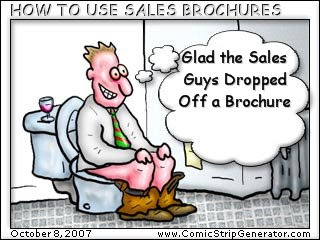
Typically executives throw away all the cutesy, excessively long-winded corporate gobbledygook brochures as soon as the salesperson leaves the room. Or they will store them on a large dusty file cabinet — until they find a need for useless paper.
Some other findings of the analyst study were interesting as well.
Buyers will pay for …
- high integrity,
- fast return on investment,
- inexpensive operation,
- easy implementation, and
- excellent service.
But how is that different from 20-30-40 years ago? And isn’t that applicable to any buyer? Any industry? Any country?
Buyers Want What They Want
Buyers are pretty basic. They want what they want. Understanding, practicality and their problems solved – whatever they are.
Would You Buy From This Company?
“We provide…
- low integrity,
- no return on investment,
- expensive products,
- hard-to-implement products, and
- the world’s worst customer service.”

Just a wild guess … but I’m thinking not.
The Value Of Being a Simpleton
I like simple messages (I’m a simpleton) that give me four tools to combat the four too’s.
The Four Tools
- What do you do?
- How do you do it?
- What makes you different from others?
- Why should I buy from you (value proposition)?
I know.
Too simple.
But, having recently this corporate hypothetical supraluminal messaging,
“We build, sell and support hypothetical superluminal quantum particle applications with ERP, CRM, BPM, MRM and PLM functionality targeted at horizontically vertical market particularities with platform-neutral ‘LMNOP” (sorta clever, alphabetically speaking) interoperability.”

I find I still prefer…
- What do you do?
- How do you do it?
- What makes you different?
- Why should I buy from you (value proposition)?
END
Do You Know …
The one skill that’s considered to be an absolute “must have” in the complex sale?
The Definition
The complex sale typically refers to a high-value purchase, $150,000 and higher, involving a buyer’s committee consisting of anywhere from five to 20 people … or more. The sales cycle is long – from 12-36 months – and involves multiple stakeholders.
And … multiple decision-makers, all with different viewpoints, agendas and usually radically different personalities.
It’s a Science – It’s an Art
To win at the complex sale, one must be a storyteller, master tactician, strategist, cajoler, evaluator, philosopher, psychologist, bean counter and techno-geek. Yup. All rolled into one. But, even with all of that, there is one skill that is an absolute “must have” in the complex sale. Without it, success is always a delayed sales cycle away – with a morbidly high improbability rate of closure ranging from 0 to 10 percent.
What is that one trait that’s an absolute “must have” to win the complex sale in today’s competitive sales environment? I’m sure you’re thinking some highfalutin, corporate gobbledygook, acromoronic description is coming your way now.
You’d be wrong.
The skill is critical to your success – in business or life. You must be
“Good in a Room.”
What does that really mean … to be “Good in a Room?” To find out I asked someone that had sat on the other side of the fence. A buyer. But not just a buyer of any high-value product or service. A buyer of ideas. Concepts. Words. A buyer of screenplays and stories. Each one a high-value purchase triggering the complex and bewildering process that may eventually lead to the big screen. And, as you’ll see, no movie ever gets started without someone having mastered the “art of the schmooze” and being …”Good in a Room.”
Enter Stephanie Palmer
Good in a Room founder Stephanie Palmer was named one of the “Next Generation: Top 35 Executives Under 35” by The Hollywood Reporter. As the Director of Creative Affairs at MGM Pictures, she acquired screenplays, books and pitches and supervised their development. Some of her projects include “Be Cool,” “Legally Blonde,” “Sleepover,” “A Guy Thing,” “Agent Cody Banks,” and “Agent Cody Banks 2: Destination London.” Prior to MGM, she worked in development at Jerry Bruckheimer Films on “Con Air,” Armageddon,” and “Enemy of the State.” Her first job in the business was as an intern on “Titanic.” She is also the author of the book “Good in a Room.”
Ten Tips for Being “Good in a Room” – Stephanie Palmer
You’ve worked for months (or years!) on your project, and a buyer is interested. The meeting is set, and there’s a lot at stake. You’re going to get one chance to effectively communicate the value and uniqueness of your project. Many people get nervous at this point.
The best of the best, however, follow these ten tips. If you learn them, you can join the ranks of those who know that they are “good in a room.”
1. Silence is the strongest start of all.
Don’t start talking until the decision-maker is ready. If there have been a lot of people popping in, urgent phone calls or other interruptions, ask the executive if he or she is ready for you to begin. Make eye contact. Then, start slowly and deliver your first line. Make sure it is dynamite. Pause. Gauge the executive’s response. Then proceed with your presentation at a relaxed pace. Remember, even though you’re intimately familiar with your project, the buyer will be hearing it for the very first time.
2. Understand the buyer’s secret dream.
Even though top-level buyers can seem cold and recalcitrant, this is the result of seeing a seemingly endless stream of poorly prepared and emotionally needy sellers deliver mediocre pitches. Decision-makers don’t wake up thinking, “I can’t wait to disappoint people and pass on 30 projects today.” Instead, they hope today will be the day they discover their career-making project. Thus, you must position yourself and your project in a way that differentiates you from the masses and speaks directly to the buyer’s highest-priority needs.
3. Build rapport. Then, build some more.
People want to work with people they like. Think about what you have in common with the decision-maker you’re meeting. Be ready to share a few brief, personal stories which demonstrate the attributes you believe will be most attractive to the buyer. Be prepared to ask a few open-ended questions that will encourage the buyer to speak about a non-business interest in a positive light.
All else being equal, you will have the edge if you can establish a personal connection.
4. Make your pitch repeatable.
Though you are selling your project to a decision-maker in the room, after the meeting, the buyer – if interested – becomes the seller and must pitch your idea to their colleagues or superiors. In Hollywood, this is known as the “logline.” If you can’t summarize your project in a brief, compelling statement, you haven’t thought about it enough.
Remember, the more you say, the less people hear.
Choose your words carefully.
5. Acknowledge the competition.
Be prepared to answer questions such as, “What does my project have in common with other successful projects in the same industry? What were the last projects that the company purchased, and were they successful? Which of their projects is most similar to my own? What makes me the best person for this project?” Answering these key questions early in your presentation demonstrates that you have done your homework.
This will encourage them to listen to what follows more closely.
6. The best meetings are conversational and interactive.
Many professionals make the mistake of performing an over-rehearsed spiel that sounds like an infomercial for their idea. Instead, pause frequently, especially when there is an opportunity for the buyer to give you a reaction or ask a question. In an ideal world, you’d spend more time in a dialogue with the buyer, than performing a monologue.
7. Start from the beginning – always.
Even if you had a long and productive conversation the day before, you’d be surprised how much can change in the buyer’s mind. After all, you’ve been thinking about the meeting and they have, too. Assume that they’ve done more research, talked to some people and something has changed since the time you last spoke. It’s your job to figure out what that is. After some initial rapport building, do another information-gathering session. If appropriate, ask for a recap from their perspective.
8. Watch for hidden opportunities.
The buyer’s goal for the meeting may not be the same as yours. In addition to hearing your idea, the executive may be evaluating you to see if you would be a good fit for another project. Remember, when you are in the room, you are selling minimally two things: your project and yourself. Even if the meeting doesn’t result in a “yes,” making a favorable impression can be the beginning of a long-term professional relationship.
9. Don’t claim your expertise – demonstrate it.
Don’t just talk about your experience, show your expertise by positioning your project as it relates to the competition. Don’t brag or boast about past wins. If you must mention a past success, do it off-handedly and with humility. This is similar to the common rule about storytelling, “Show, don’t tell.” Remember a lot of people talk the talk. Those who are “good in a room” are focused on meeting the needs of the buyer and not on boosting their own ego.
10. Save a surprise for the end.
Plan multiple strategies to exit gracefully. Some techniques are to have a callback to a personal topic that you discussed at the beginning of the meeting, thank them for a specific, useful contribution they made during the meeting, or leave them a polished piece of material that they haven’t seen previously. Use a summary statement that you design specifically to be remembered and repeated. Remember, last impressions last.
Surprise! Bonus tip.
11. You are always in the room.
Develop your skills so that you can handle meetings that occur unexpectedly, like on a plane, at a party, or in a waiting room. More business starts from casual interactions than formal meetings across a conference room table. The polished professional who is “good in a room” is ready for anything. But don’t feel the need to talk business in all situations, often the best move is to say, “Why don’t we just enjoy the party, and I’ll follow up with you on Monday.” To sign up for Stephanie’s free monthly column “Inside the Room,” Click HERE
END:
CONTACT:
Stephanie Palmer
Good in a Room
10845 Lindbrook Drive, Suite 200,
Los Angeles, CA 90024
Phone: 310.481.3987
Fax: 310.388.0818
Email: [email protected]
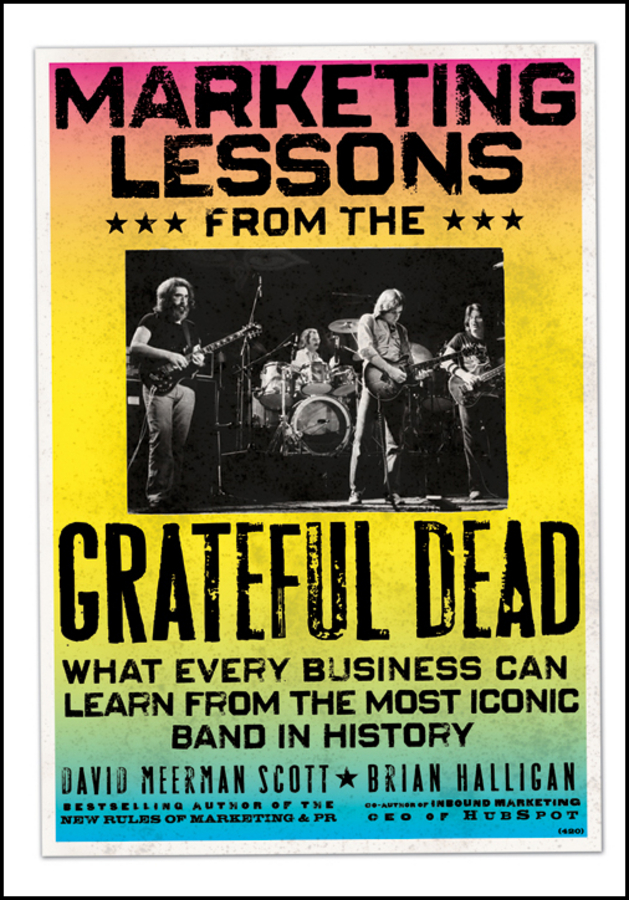
Author David Meerman Scott and Brian Halligan, CEO of Hubspot, have a new book out that’s generating a lot of Buzzzzzzzzz …
David and I have known each other since 2005. Since that time he’s written several great books including the international bestseller “The New Rules of Marketing and PR: How To Use News Releases, Blogs, Podcastiing, Viral Marketing & Online Media to Reach Buyers Directly,” which has been translated into 26 languages.
David’s writing is crisp, clean, easy to read and always full of helpful information and unique ways to authentically connect with people—and grow your business. That’s hard to pull off.
WRONG
I’m usually 100% supportive of David’s ideas and insights. Not this time. I think he and Brian got it totally wrong on the name and naming of the “Grateful Dead.”
RESEARCH
They must not have done their research. Had they done in-depth historical musical research, they would have uncovered where the Grateful Dead name really came from.
THE SECRET
As a business courtesy (back-stabbing) to David and Brian, it will be revealed here for the first time. That’s right. The real secret behind the naming of The Grateful Dead. Maybe David and Brian can correct their story in the second printing of the book to give credit where credit is due.
ALL FAIRNESS ASIDE
But, in all fairness, I’ll let them make their case first. Then I’ll expose their inaccuracies. Rip them to shreds. Professionally of course. But be prepared – some graphic pictures are coming your way. It may not be suitable for all readers. Make sure any kids under 50 are not in the room when you read this.
THEIR CASE …
A Marketing Lesson from the Grateful Dead – Choose Memorable Brand Names
By David Meerman Scott and Brian Halligan
The Grateful Dead.
If you stop to think about it, the name is sorta weird. Even a little scary.
But boy is it memorable.
Originally calling themselves The Warlocks when they formed in 1964, members of the band realized they needed to come up with a new name a year later when they found out that there was another band by the same name that had recorded a single. The guys debated names, suggesting ideas such as “Mythical Ethical Icicle Tricycle” (Garcia) and “His Own Sweet Advocates” (Weir). When they were unable to find a name they agreed on, they gathered at Phil Lesh’s house around a copy of Bartlett’s Quotations, read out a thousand possible names, but couldn’t agree on anything. Then Jerry Garcia opened a copy of Funk and Wagnall’s New Practical Standard Dictionary (1956 edition) and randomly pointed to a page. There, staring back at him, was GRATEFUL DEAD. Several members immediately fell in love with the name and wanted to use it. Others were a bit wary. But all agreed it was memorable so they decided to use it.
Love it, hate it, or don’t understand it—the Grateful Dead is a name that you remember.
A name–like the Grateful Dead–is an asset to an organization choosing wisely. When you select an uncommon name (and one appropriate to your company image and target market) it’s unlikely that consumers will confuse your product with something similar. They will remember you. And in today’s world of online communications and of search engines, unique names for your company, products, and services allow you to own the search engine results for your brands.
Most companies don’t focus enough attention on choosing a memorable name or to the importance of Google, Bing, and other search engines when selecting those names. Typically people closest to the product development effort are the ones proposing the candidate names. This usually leads to overly technical names focused on what a product does (something like “MP3 Deluxe Pocket Player” rather than a memorable name that appeals to customers like “iPod”). At most companies, candidate names are vetted by the legal department for copyright and trademark issues that would disqualify use, but few bother to do a Google search on the potential new name. If your company’s website is not on the first page of the Google results with your product name, that should disqualify it as an option.
Naming is tough. But it is a very important element of marketing. Most organizations don’t spend enough time on this important activity.
Action: Here are some things to keep in mind and a few tricks you might try as you think of a name:
- Avoid common names and names that are already used as a title of a popular movie or book. You will want to have a name that you can have the top listing for in the search engines.
- Use search engines before finalizing a name. You don’t want to fall in love with a name that you cannot have the top search results for.
- Find inspiration in unlikely places. Why not go to one of the online booksellers (such as Amazon.com, BN.com, or Borders.com in the US) and search on the name of the category of product you are trying to name. You’ll see a list of book titles and subtitles that may spark an idea.
- Many people choose made up words as a name. This is great because you can own the search results. But try not to choose one that is too esoteric or difficult to pronounce if you go this route.
- You might take two words that are very different and put them together as one word like SurveyMonkey, an intriguing company name.
- Try an alternative spelling for a word. Google is a derivation of the word “googol,” a number that is ten to the power of one hundred (the numeral one followed by 100 zeros). Flickr is “flicker” with an “e” removed.
- In her excellent book POP!, Sam Horn (http://www.samhorn.com) talks about what she calls “alphabetizing” common words to come up with a name. We like this technique. Take a common product you want to name, for example, Yogurt in a squeeze tube. Then go through every letter in the alphabet and substitute it for the “Y” in Yogurt and presto: “GoGurt” is born.
- Take a common name and change it slightly to create a new word. For example social networking site FledgeWing is a derivation of the word “fledgling.”
END OF THEIR CASE – NOW IT’S MY TURN
That’s history as it’s recorded. The mythological muses smile on Jerry Garcia and the band and out POPS the name The Grateful Dead. It’s true that the name is memorable. But history is always written by the victors – biased biographies of the victorious.
THE REST OF THE STORY ( I’m sure Paul Harvey did this story once)
The real story was that there was this kick-butt band called “The Grateful Donk” that Jerry Garcia and the boys saw play at the Donkey Dewd Don’t You Drop Inn bar in Haight-Asbury in 1964. They were mesmerized – especially by the melodiously mellifluous kilt-wearing piano player and the talented Equus Africanus (Ass) lead guitarist.

David and Brian should have made full disclosure on this issue – they were there. Check out the picture. Really. It’s not “Where’s Waldo“; Brian and David are herein both graphically exposed.
EXPOSED
And being exposed was actually the downfall of this once-mighty band with so much potential. See the kilt-wearing piano player above? See how he’s rocking out doing his smoking best Jerry Lee Lewis ivory-licks? See the Grateful Donk fans in the front row? I mean the shocked, horrified and distressed-looking ones?
Well … getting to the bottom of it, the piano player, he uh, forgot something. Went kilt-kommando so to speak.
And you know that name?The Grateful Donk?
Love it, hate it, or don’t understand it—The Grateful Donk is a name that you remember
![Kilt Kommando small[3]](https://stevekayser.com/wp-content/uploads/2010/07/Kilt-Kommando-small3-480x408.jpg)
RUINED
Well it wasn’t. The band was ruined by the exposure.
The Grateful Donk tried to regroup. They killed the kilt guy, then added a female singer and guitarist named

BONNIE BRAY-IT
But the band never recovered from the kommando-kilt incident.
Jerry Garcia and the boys cribbed the name and stole the glory after the

band fled in utter disgrace and had to disband.
The kommando-kilt wearing piano player, (much like Boston’s Bill Buckner, after “The Curse of the Bambino” caused him to boot a ball in game six, and it cost the Boston the 1986 World Series,) took the disgrace like a manly man.
 Forty years later he regrouped and now works in PR and Marketing for a software company.
Forty years later he regrouped and now works in PR and Marketing for a software company.
And now you know … the rest of the story.
Epilogue:
The Equus Africanus (ass) lead guitarist later went on to great literary fame … his name? Donkey O’Tee, author of ;

and he married? You guessed it …
 Bonnie Bray-it
Bonnie Bray-it
###
The good stuff above was excerpted from the new book (to be published August 1, 2010 by John Wiley & Sons) Marketing Lessons from the Grateful Dead: What Every Business Can Learn from the Most Iconic Band in History by David Meerman Scott and Brian Halligan. ISBN-13: 978-0470900529. Used with permission.
The Grateful Donk stuff, though historically, solidly questionable, has nothing to do with David and Brian’s new book. Go check their book out for yourself.

Visit David Meerman Scott and Brian Halligan at their Facebook Fan Page for more information on “Marketing Lessons for the Grateful Dead.”
And listen to the Grateful Donk Radio on the Blip.fm History Channel – Http://blip.fm/TheGratefulDonk no courtesy of investigative reporter @stevekayser on Twitter or Steve on Blip.fm at http://blip.fm/stevekayser
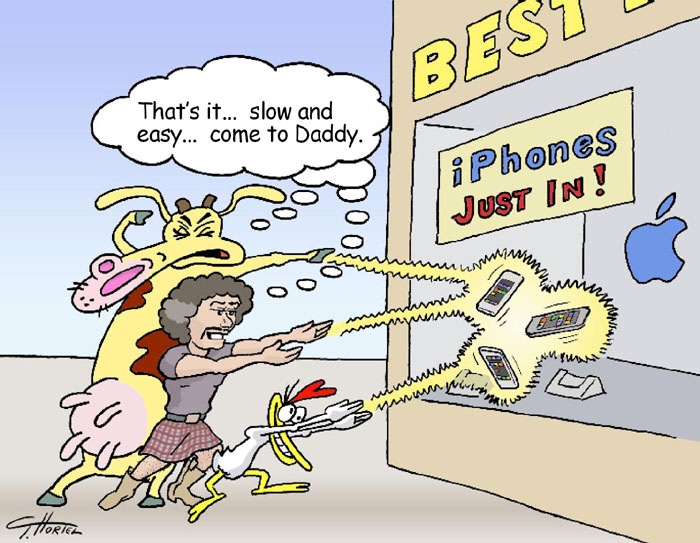
Featuring an interview with Lynne McTaggart, author of “The Intention Experiment.”

“This important book makes a good case that we are on the verge of another revolution in our understanding of the universe.” – Arthur C. Clarke
I Had Good Intentions
I fully intended to keep my 2012 New Year’s resolutions. I knew it would be hard. But I had good intentions. I had good intentions. Really.
However, even though I held out a long time – 6 days, 21 hours and 30 minutes short – of the first full week of January – I didn’t make it. I fell short. Badly. Some of it was simply from a sense of loss (also sometimes known as grief) that had weakened my resolve. Donkey O’Tee, my long-time co-writer and close friend, had left me to pursue his own career as an author (below).
Media Star

Donkey O’Tee had massive pre-sales. Five copies at least. The media loved him. He took a simple idea, complexified it to nearly an undecipherable obfuscation, eschewing logic and reason, and suddenly he was a media know-it-all star.
But, before Donkey O’Tee went on his book tour, he sensed my despair – my utter hopelessness. Donkey’s are like that. Sensitive. So, he sent two cousins of his to help me out while he was gone on tour. “Hollywood veterans” he assured me. Their names were Cal and Chichen (pronounced “chikken”) Itza (figure out which is which?) from Yucatan, a state in Mexico.
Cal, Steve and Chichen Itza

But they were a little too perky for me.
I slipped into a deep funk. I pondered why my good intentions always went awry. My hair grew out of control (which horrified my friends who were all going bald), and I seemed to shrink – grow shorter from the weight of the deep thought in which I was engrossed. Why did my “good intentions” always go so bad? Then … almost by accident (but not quite – that’s what the word almost means) I ran across a book called “The Intention Experiment – Use Your Thoughts to Change the World,” by Lynne McTaggart.
Your Life of Business … or Business of Life
I jumped eyes first into it. Speed-read it (I completed the introduction). And wow … not just a wishful “think your way to greatness and riches” bunch of crapola, but a book backed by top-notch scientific evidence. On the frontier of science, for sure, but backed by and working with an international team of renowned scientists to measure and create a “Science of Intention.” To prove your thoughts and intentions can be scientifically measured and make a real difference in this world, in your life of business … or the business of your life. The book even had an action plan and an invitation to all readers to join and be a part of the world’s largest experiment – “THE INTENTION EXPERIMENT.”
I was ecstatic.
I rushed out of the house down to the electronics store brimming with good intentions.
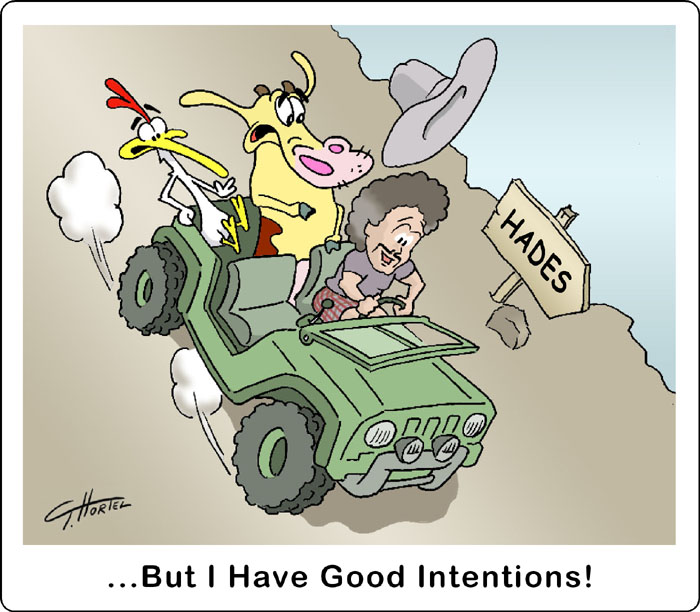
Oozing good intentions flowing like a volcanic river.
Yes, a river of good intentions.
That was me.
A NEW I-PHONE TWO WOULD BE MINE!

BUT, things didn’t quite work out the way I had envisioned.
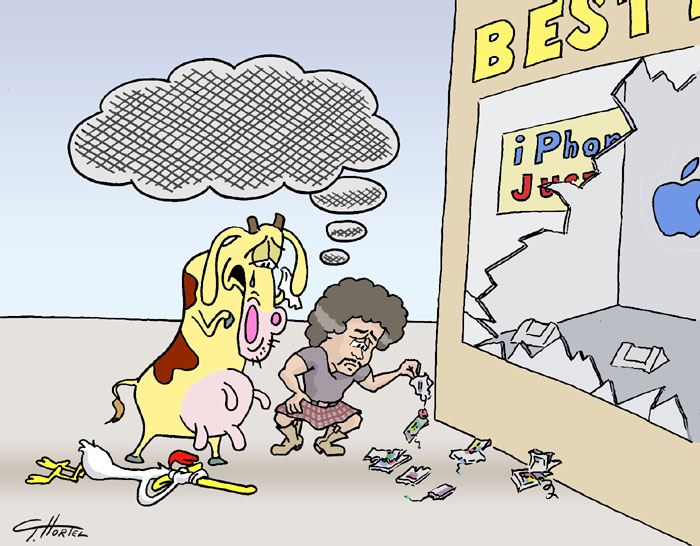
This business of thinking and intention was a bit more complicated than I thought. Or at least I think I thought I thunk that. So as usual I had to go to the source for more information.
ENTER Lynne McTaggart
Lynne is an award-winning author of five books, including “The Field,” which has been published in 14 languages. “The Field” was a major influence on the wildly successful U.S. cult classic, “What the Bleep Do We Know?” and Lynne starred in the BLEEP’s full version, “Down the Rabbit Hole Quantum.”
Steve: Hi Lynne. I tried the intention thing … it didn’t really work too well for me.
Lynne: Did you read the book?
Steve: Sorta.
Lynne: Sorta. What’s that mean in English?
Steve: Oh, I forgot you were from England. Well, it means I got carried away after reading the introduction and tried to use my good intentions for something.
Lynne: For your own benefit?
Steve: … Maybe.
Lynne: Didn’t work so well, did it.
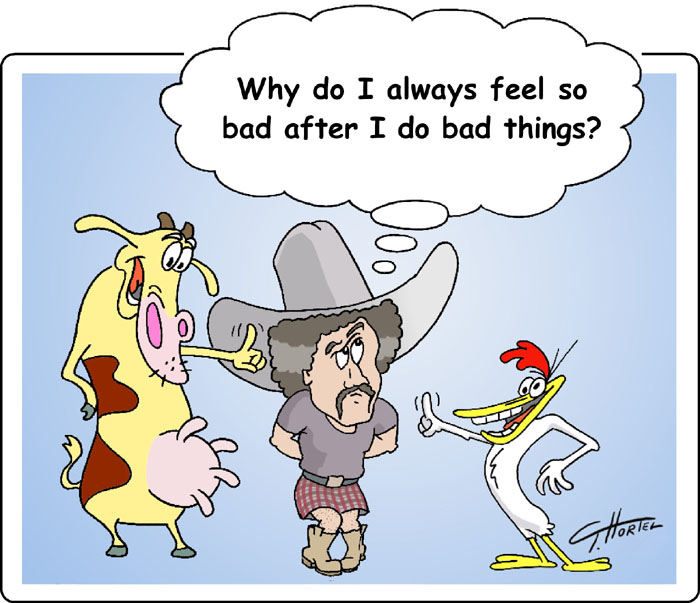
Steve: It worked, just not the way I wanted it to. So, what did I miss in the book? What did I do wrong?
Lynne: Besides just reading the introduction? The book is not about sending intentions to make a million dollars. The book is about using the science of intention philanthropically: healing wounds, helping children with attention deficit or patients with Alzheimer’s, counteracting pollution, global warming, that type of thing.
Steve: Oh. (Although the reader can’t see, chagrin may have crossed my face at this point). What else is the book about?
Lynne: “The Intention Experiment” is really some unfinished business I had with my previous book, “The Field.” It was a question (or questions) that was raised – there seemed to be anecdotal evidence to support and suggest that thoughts truly were things. A thought was not only a thing, but a thing that influences other things. A simple thought had the power to change the world. But the question was, could these thoughts and intentions be corralled, scientifically measured, tested … and used for good? The first part of “The Intention Experiment” attempts to synthesize all of the experimental evidence that exists on intention into a coherent scientific theory of how intention works, how it can be used in your life and what conditions optimize its effect.
Steve: So, an investigative scientific journey of the latest, greatest research on thought and intentionality. Who are some of the scientists involved?
Lynne: Robert Jahn, Dean Emeritus of the Princeton University School of Engineering; his colleague, psychologist Brenda Dunne, who runs the Princeton Engineering Anomalous Research (PEAR) laboratory; Dr. Gary Schwartz of the Center for Frontier Medicine in Biofield Science at the University of Arizona; and Fritz-Albert Popp, assistant director of the International Institute of Biophysics (IIB), in Neuss, Germany, to name a few.
Steve: Seriously eminent scientists. I’m familiar with Fritz-Albert Popp. His work on biophoton emissions, that DNA, molecules and cells all emit light that may be used for information communication is not only astoundingly earth-shaking and potentially has the ability to change humanity forever, but unfortunately is pretty much under-appreciated and unknown amongst 99.99% of the earth’s population. What are some of the interesting facts coming out of this research?
Lynne: You can get stronger, bigger muscles just by thinking. Some of the research findings include that athletes who do not physically exercise but only imagine their workouts can increase their muscle strength between 13 and 16 percent.
Steve: By just imagining the exercise?
He’s the Greatest!
Lynne: Yes. Imagine the implications for business. For sales. For marketing. Anyone can see tremendous improvements in their personal or business lives by rehearsing specific activities before actually doing them. Muhammad Ali, one of the greatest, if not greatest, athletes of all times was a master of thought, intention and visualization. He’s covered in the book.
Steve: Other results?
Lynne: Atoms can become entangled and behave as one single giant atom. Human bodies can act as transmitting and receiving antennas, living things demonstrate awareness of the well-being of other living things around them. A sizable body of scientific research, carried on for more than 30 years in prestigious scientific institutions around the world, show that thoughts are capable of affecting everything from the simplest machines to the most complex living beings.
Steve: What do you mean by “intention?”
Lynne: A textbook definition of intention is “a purposeful plan to perform an action, which will lead to a desired outcome,” unlike a desire, which means simply focusing on an outcome, without a purposeful plan of how to achieve it.
Steve: How could I (and the reader) use the science of intention?
Lynne: That’s in the second part of my book. I offer a blueprint for using your thoughts and intentions effectively in your own life through a series of exercises and recommendations. These exercises will show you how to “power up” your own thoughts and intentions to change your life and those around you. It’s also an exercise in frontier science – albeit personal.
Steve: And you do live group experiments via the internet?
Lynne: Yes, with the aid of our readers and our highly experienced scientific team, we conduct large-scale group experiments via the internet to determine whether focused intention has any scientifically quantifiable effects on selected targets.
Steve: How does one get involved?
Lynne: Go to our website for details The Intention Experiment. The first studies will be carried out by physicists Fritz-Albert Popp, vice-president of the International Institute of Biophysics in Neuss, Germany (www.lifescientists.de) and his team of seven; psychologist Gary Schwartz and his colleagues at the University of Arizona at Tucson; and Marilyn Schlitz and Dean Radin of the Institute of Noetic Sciences. You can see the rest of the scientific team on our web site too.
Steve: How will this be controlled? The WWW is full of World-Wide-Whackos, full of in-laws, outlaws and hackers who enjoy mucking things up.
Lynne: Website experts collaborated with our scientific team to design secure log-on protocols and to enable us to identify which characteristics of a group or aspects of their thoughts produce the most effective results.
Steve: An example?
Lynne: A patient with a wound. It is known that wounds generally heal at a particular, quantifiable rate with a precise pattern. Any departure from the norm can be precisely measured and shown to be an experimental effect. In this example, our aim would be to determine whether focused group intention will enable wounds to heal more quickly than usual.
Steve: Hmm. I knew that. And your ultimate plan for these experiments?
Lynne: They’re ambitious. To recruit hundreds of thousands, maybe millions of volunteers from around the world to participate in these series of web-based experiments, to try to tackle a number of societal ills. It will be the largest mind-over-matter study in history.
Steve: Can I take part in your experiments? Can I? Can I?
Lynne: I’d like to send a special letter about it to you and your friends, Cal and Chichen. Is that okay?
Steve: That’d be great! (feeling special … even if she did include the freako animals) Thank you, and best wishes to your readers and scientific team Lynne.
Lynne: Thank you. Intention me on Twitter if you get a chance.
TIME PASSED
True to her word – a special letter did arrive.
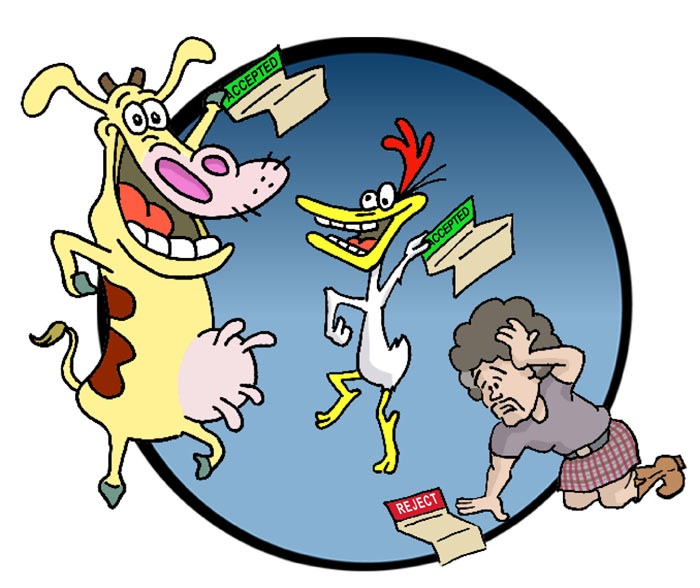
END:
Lynne McTaggart is an award-winning author of five books, including “The Field,” which has been published in 14 languages. “The Field” was a major influence on the wildly successful U.S. cult classic, “What the Bleep Do We Know?” and Lynne starred in the BLEEP’s full version, “Down the Rabbit Hole.” Lynne is an internationally recognized spokesperson on the science of spirituality and also co-executive director of Conatus, which publishes the UK’s most well-respected health and spiritual newsletters and online information including “What Doctors Don’t Tell You” and “Living the Field.”
About Steve Kayser
He’s currently too busy to write his bio because he’s engaged in a scientific experiment …

Twitter.
A simple micro-blogging service.
Nothing more. Nothing less.
Ha!

But professional purveyors of corporate gobbledygook know, yes they know, Twitter is a tool straight from hell.
A demon dalliance.
Seed of Satan.

Fathered to challenge sesquipedalian pontifications that mean nothing to no one.
Nothing to no one.
What’s it Mean Steve?
Death to long copy.

Twitter imperils wordsmithereen evil-ese at it’s basest, non-productive most non-valuable essence.
National Security Threat
Twitter threatens …
National Security.
Job Security.
Retro-strategic de-innovation.
Professional obfuscation.

Those in the know, know, the Wall Street collapse and panic can be laid directly at the Tweet of Twitter.
Why?
Because everything posted on Twitter has to be 140 characters or less.
For you Non-Twits, that’s about 15-22 words.

It forces you to be concise, clear and short.
Small words.
Short sentences.
Shorter URL’s.
Can you imagine?
Or could this be …
Could this be, possibly, a sign of the …

Nahh …
I just wanted to use cartoons of Inspector Gadget, and Satan along with the word “Twitter” and phrases “WALL STREET PANIC” and “The End Times” in the title.
I think it had something to do with overeating my favorite cuisine tonight – chili with peanut butter, beans, salmon, jelly, mayonnaise, jalapeno peppers and anchovies, washed down with a quart of chocolate beer.
That might have been it.
However, all seriousness aside, those in the know, know – you just never know.









![Kilt Kommando small[3]](https://stevekayser.com/wp-content/uploads/2010/07/Kilt-Kommando-small3-480x408.jpg)




















Recent Comments
Lessons Learned from Hollywood STORY Guru Robert McKee